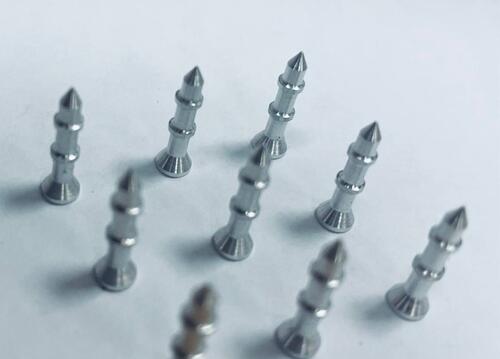A team of materials scientists from NUST MISIS has presented a new alloy based on magnesium, zinc, gallium and yttrium, which can be used as a material for modern jaw implants. The patient doesn’t need to be re-operated, as the implants gradually dissolve in the body simultaneously with the growth of a new area of bone tissue. The research results are published in the Materials international scientific journal.
Implantologists use magnesium and alloys based on it as a temporary fixation of bone tissue, as they have a high level of biocompatibility and the ability to gradually dissolve in the human body as the healing process progresses. At the same time, Young’s modulus (a physical quantity that characterizes the properties of a material to bend or stretch under the influence of force) of magnesium and its alloys are close to Young’s modulus of human bone tissue. This, in turn, can prevent the stress-shielding effect observed for titanium alloys, which are widely used in surgical practice but are more “rigid”. Due to the stress-shielding effect, the neighboring healthy bones are not sufficiently loaded and are being gradually destructed and, as a result, a decrease in density occurs. In the future, this threatens to loosen the implant and destroy the bone.
A group of materials scientists from NUST MISIS was interested in gallium as an alloying component for magnesium alloys, as it has been clinically proven that gallium ions are effective against bone resorption and are used to treat osteoporosis and hypercalcemia associated with oncology. The scientists have described the optimal technology for creating an alloy of the magnesium-zinc-gallium-yttrium system, namely the effect of various heat treatment modes on the microstructure, mechanical and corrosion properties of the final composition.
“As a result of several laboratory experiments, we have found that solid-solution heat treatment improved the mechanical properties of the alloys, and the low corrosion rate in Hanks’ solution was achieved because of the decrease in the cathodic-phase content after heat treatment,” says the co-author of the study, head of the NUST MISIS Hybrid Nanostructured Materials Laboratory, Ph.D. Alexander Komissarov.
According to the developers, analysis of various heat treatment modes influence on the properties of the alloy has shown that the optimal temperature and time are, respectively, 350 °C and 18 hours, followed by quenching in water. The results of corrosion tests have shown that the addition of yttrium to the alloy composition reduces the corrosion rate in the solution by a factor of 2.
“Alloys with a ratio of zinc and gallium close to 1 have approximately the same corrosion rate of ~0.6 mm/year. For alloys with a ratio of zinc and gallium equal to 2 and 3.25, the corrosion rate was 0.78 and 1.03 mm/year, respectively. The addition of yttrium reduced the corrosion rate from 0.59 to 0.27 mm/year due to the inhibitory effect of the corrosion layer products. Thus, by changing the zinc and gallium ratio in the chemical composition of the magnesium alloy, we can control the corrosion rate of implants,” adds the key project executor, associate professor of the Department of Foundry Technology & Artistic Processing of Materials at NUST MISIS, Ph.D. Vyacheslav Bazhenov.
Thus, magnesium alloy with additions of zinc, gallium and yttrium, heat-treated according to the proposed regime, can be used to create maxillofacial implants due to high mechanical properties and low bioresorption rate. The presence of gallium in the composition of alloys will give them new, unique properties and help restore damaged bone tissue of patients.
At the moment, the developers are preparing to start preclinical studies of implants based on the new alloy at the site of one of the Russian veterinary clinics.





